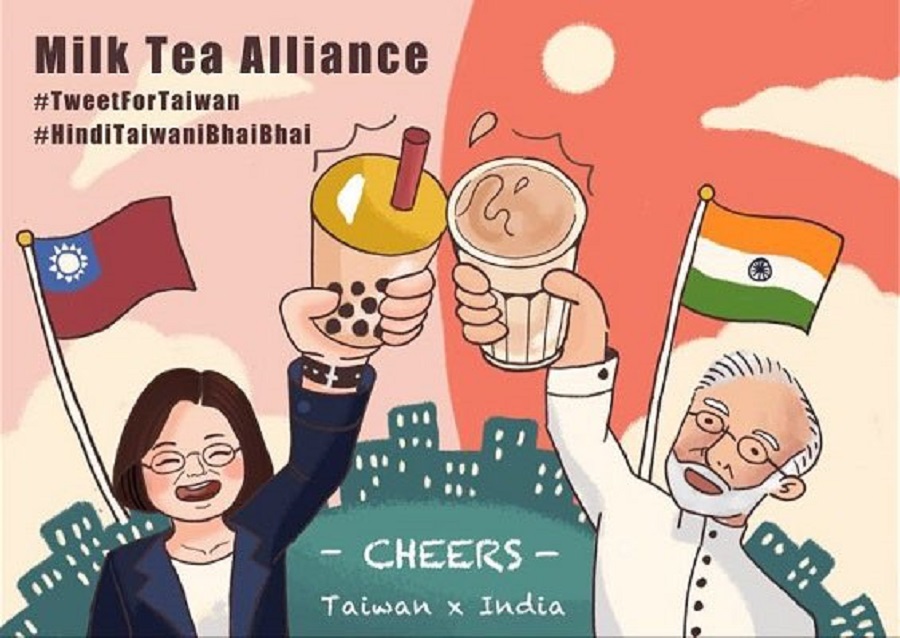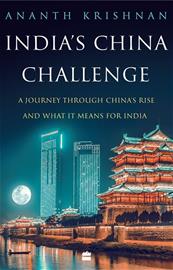Guest Column
The Taiwan–India ‘Milk Tea Alliance’
By Jassie Hsi Cheng
 Image credit: Twitter/Digital Diplomacy Lab
Image credit: Twitter/Digital Diplomacy Lab
“TAIWAN Happy National Day October 10,” read the posters congratulating Taiwan on its 109th National Day. They were put up near the Chinese embassy in New Delhi on the 10th by India’s ruling BJP spokesperson, Tajinder Pal Singh Bagga. Even though they were soon taken down, images of the signs had already gone viral on Twitter and in the press. They were joined by a meme tweeted by Indian netizens in support of Taiwan. Titled “Milk Tea Alliance,” … the meme showed Taiwan’s President Tsai Ing-wen and India’s Prime Minister Narendra Modi toasting each other with bubble tea and Indian spiced tea.
This represented a huge humiliation for Beijing, as the Chinese Embassy in Delhi had specifically issued a diktat to the Indian media a few days before Taiwan’s Double Tenth Day, … asking them not to violate its “one China” policy. As expected, this diktat sparked a backlash on social media and had a so-called Streisand effect … Tsai thanked the Indian people for their blessings and support, and on the day the posters went up, Taiwan’s envoy to the U.S., Hsiao Bi-khim, tweeted, “Wow! What a #MilkTeaAlliance.”
This is an except from an article originally published in The Diplomat on October 20, 2020 and is reprinted with permission. See the full article here.
Jassie H. Cheng is a Research Associate at the Centre on Asia and Globalisation (CAG) at the Lee Kuan Yew School of Public Policy, National University of Singapore. Previously, she was a press researcher responsible for public relations activities and communications at the Taipei Representative Office in the U.K.
The views expressed in the article are solely those of the author(s) and do not necessarily reflect the position or policy of the Lee Kuan Yew School of Public Policy or the National University of Singapore.
News Reports
Bilateral relations
China draws up a peace plan on Ladakh. India sees right through it
Hindustan Times, October 30
Army finds PLA’s condition that India should only patrol till Finger 3 of Pangong Tso unacceptable as it means that Finger 4 will become part of occupied Aksai Chin.
India takes its tussle with China to the high seas
Financial Times, October 28
New Delhi quietly dispatched a frontline warship on an unusual voyage to the South China Sea.
India in dialogue with China to end six month old military standoff: Rajnath Singh
Livemint, October 28
Defence Minister Rajnath Singh said India was in dialogue with China to end a six month old military standoff and commended the Indian army for standing firm against any possible attempts at intrusion by the Chinese forces in the mean time.
Against China, India needs to be militarily better prepared, says RSS chief Mohan Bhagwat
Hindustan Times, October 25
Rashtriya Swayamsevak Sangh (RSS) chief Mohan Bhagwat said India needs to be more powerful than China in terms of military preparedness, adding the world is aware of that country’s expansionist designs.
India-China standoff: ITBP to set up 47 new outposts for better vigil
DNA India, October 25
Amid rising tensions with China along the Line of Actual Control, the government has ordered setting up of 47 Border Outposts (BoPs). The Indo-Tibetan Border Police (ITBP) will set up and man these Border Outposts.
India-China border standoff: Ensuring comprehensive disengagement is 'immediate task'
The Economic Times, October 22
"The immediate task is to ensure a comprehensive disengagement of troops in all the friction areas,” said the spokesperson in the Ministry of External Affairs (MEA) Anurag Srivastava.
News Reports
China and India in the Region
US
counters China in Sri Lanka and Maldives by driving a wedge
Nikkei Asia, October 30
Pompeo
announces opening of Male embassy and calls Communist Party a 'predator'.
Communication channels
on China-India border issues unimpeded, Indo-Pacific strategy outdated Cold War
mentality: Chinese FM
Global Times, October 28
The
Indo-Pacific strategy proposed by the US advocated an outdated Cold War
mentality, promoted bloc confrontation and upheld the dominant position and
hegemonic system of the US, Wang Wenbin said, urging some US politicians to
stop hyping up the so-called China threat and sowing discord between countries
in the region.
With
a message for Pakistan and China, India & US conclude 2+2 talks, vow to
deepen ties
The Print, October 27
The biggest takeaway from the talks was the signing
of BECA, a key defence pact that will enable India to avail of US expertise on
geospatial intelligence.
China’s
hand seen in Myanmar’s insurgent group targeting India-backed Kaladan project
Hindustan Times, October 26
The Arakan
Army, an insurgent group whose activities have severely affected the
India-backed Kaladan multi-modal transport project in Myanmar, has benefited
from the clandestine transfer and smuggling of Chinese-made weaponry, people
familiar with developments said on Monday (October 26).
China right to be concerned about Quad alliance’s bright future, analysts say
South China Morning Post, October 24
After unpromising beginning, US, Japan, India and Australia grouping is finding renewed common ground against Beijing.
News Reports
Trade and Economy
Chinese promise market opening amid technology push
Yahoo Finance, October 30
China will promote “technological self-reliance” under the ruling Communist Party’s latest five-year plan but will open further to trade, officials said Friday (October 30).
India can still be $5 trillion economy, says PM Modi
Business Today, October 29
Prime Minister Narendra Modi has said he's optimistic about achieving the $5 trillion dollar economy target by 2024, despite coronavirus pandemic ravaging the Indian economy.
Sustained Chinese demand pushes up iron ore, steel prices in India
The Times of India, October 28
Steel prices are riding high on export demand, with China playing an important role.
India, China Get Richer As Virus Hits US Wealth: Credit Suisse
NDTV, October 23
Only China and India saw gains in household wealth in the first half of the year, growing by 4.4% and 1.6%, respectively.
India will slip to seventh largest economy in 2021, shows IMF data
Business Standard, October 23
China is not just firm at the No. 2 spot, but is nearing the US fast.
News Reports
Energy and Environment
US pitches cheaper solar technology to India amid high dependence on China
Livemint, October 29
The US wants India to explore manufacturing a cheaper alternative to silicon solar cells, U.S. Energy Secretary Dan Brouillette said on Wednesday (October 28), amid high dependence on Chinese technology.
Xi's carbon neutrality vow to reshape China's five-year plan
Reuters, October 26
Policymakers are under pressure to include radical climate targets in the new 2021-2025 “five-year plan”, with the COVID-hit economy weighing on their decisions.
At India Energy Forum, PM Modi says India’s energy future bright and secure
Hindustan Times, October 26
Promoting India’s capability to be a global force multiplier, PM Modi said, “A self-reliant India will also be a force multiplier for the world economy. Energy security is at the core of our efforts.”
Analyses
How the US and India became brothers in arms
Asia Times, October 28
By Jagannath Panda, Research Fellow and Coordinator of the East Asia Centre at MP-IDSA, New Delhi
India and US have overcome historically rocky relations to forge a key defense pact aimed primarily at China.
Incentives to advance India-US partnership are stronger than ever before
The Indian Express, October 27
By C. Raja Mohan, Director, Institute of South Asian Studies, National University of Singapore
The 2+2 dialogue comes in the backdrop of a structural shift in great power politics and turbulence in the global economic order.
India can play a constructive role in evolving a multipolar and just world order
The Indian Express, October 26
By D. Raja, General Secretary, CPI
India pursuing an independent foreign policy is not only essential for the country or the South Asian region, it can have a bearing on deprived populations of the world.
India is caught between the need for good China relations and rising public anger
South China Morning Post, October 26
By Mohamed Zeeshan, editor-in-chief of Freedom Gazette
Indian officials have used cautious rhetoric in the hope of easing tensions with China and keeping up Delhi’s foreign policy balancing act between East and West.
India aims at maximum interests with BECA
Global Times, October 25
By Zhang Jiadong, Director of South Asian Studies Center at Fudan University and Professor of American Studies Center
In the long run, in a multipolar world, US-Indian relations will continue to develop, but will also transform. It's difficult for Washington to form alliance with New Delhi like it has with Tokyo.
How Russia emerged as key mediator in the China–India dispute
East Asia Forum, October 23
By Artyom Lukin, Associate Professor and Deputy Director of Research at the School of Regional and International Studies, Far Eastern Federal University, Vladivostok
Russia has become the de facto intermediary in the dispute, despite never publicly offering. Moscow’s discreet diplomacy may have helped de-escalate the most violent China–India clash since the 1960s.
Books and Journals
 India’s China Challenge: A journey through China’s rise and what it means for India
India’s China Challenge: A journey through China’s rise and what it means for India
HarperCollins, September 2020
By Ananth Krishnnan, Beijing correspondent for The Hindu
This book is Krishnan’s attempt at unpacking India’s China challenge, which is four-fold: the political challenge of dealing with a one-party state that is looking to increasingly shape global institutions; the military challenge of managing an unresolved border; the economic challenge of both learning from China’s remarkable and unique growth story and building a closer relationship; and the conceptual challenge of changing how we think about and engage with our most important neighbour. India’s China Challenge tells the story of a complex political relationship, and how China – and its leading opinion-makers – view India. It looks at the economic dimensions and cultural connect, and the internal political and social transformations in China that continue to shape both the country’s future and its relations with India.

Compiled and sent to you by Centre on Asia and Globalisation and the Lee Kuan Yew School of Public Policy, National University of Singapore.
Have any feedback or comment? Email us
decb64_Y2FnQG51cy5lZHUuc2c=_decb64
Subscribe